
- A place to relax and read a book, watch a movie, or use a computer
- A place to entertain guests during the summer months
- A place that can be used all year round regardless of the weather
Different types of sunrooms
- Sunrooms
- Screen Rooms or Patio Covers
- Conservatories
- Solariums
1. Sunrooms
Sunrooms are the most common type of sunroom. They are designed to incorporate the indoors with the outdoors, enabling you to enjoy the sun even when it’s raining or cold outside.
Sunrooms can be made from a variety of materials, including but not limited to:
a) Glass
b) Wood
c) Vinyl
d) Polycarbonate
Each of these materials has their own unique benefits and drawbacks, which are discussed below.
a) Glass
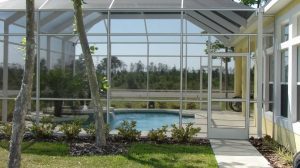 Pros – Glass is very affordable and allows for natural light to enter the room. This ensures that the sunroom will be bright, regardless of how many windows it has.
Pros – Glass is very affordable and allows for natural light to enter the room. This ensures that the sunroom will be bright, regardless of how many windows it has.
Cons – Glass can be fragile and is not as durable as other materials. It can also be difficult to keep clean, which may require more maintenance than other materials.
b) Wood
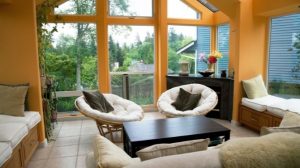 Pros – Wood is a versatile and durable material, which makes it perfect for sunrooms. It also requires very little maintenance.
Pros – Wood is a versatile and durable material, which makes it perfect for sunrooms. It also requires very little maintenance.
Cons – Wood can be expensive, is susceptible to the elements, and the exterior walls of the sunroom must be insulated.
c) Vinyl
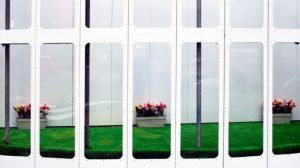 Pros – Vinyl is a very affordable option, is easy to maintain, and is available in a variety of colors and styles.
Pros – Vinyl is a very affordable option, is easy to maintain, and is available in a variety of colors and styles.
Cons – Vinyl will not look as natural as wood or glass, and is prone to cracking.
d) Polycarbonate
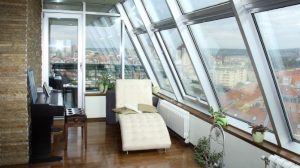 Pros – Polycarbonate is very durable, which means it is more suitable for very harsh conditions. The material is also resistant to the elements, has an attractive look, and can be made into any shape or size.
Pros – Polycarbonate is very durable, which means it is more suitable for very harsh conditions. The material is also resistant to the elements, has an attractive look, and can be made into any shape or size.
Cons – Polycarbonate is more expensive than other materials, and it can be difficult to install.
2. Screen rooms or patio covers
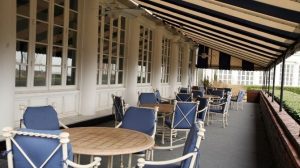 Screen rooms or patio covers are designed to provide shade and shelter from the elements, but they do not have walls.
Screen rooms or patio covers are designed to provide shade and shelter from the elements, but they do not have walls.
This means that they cannot be used all year round and are only suitable for use during the summer months.
Pros – Screen rooms or patio covers are very affordable and easy to maintain.
Cons – Screen rooms or patio covers cannot provide full sun exposure, as they do not enclose the space like other options.
3. Conservatories
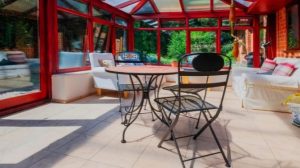 Conservatories are designed to provide ample sun exposure, which makes them suitable for year round use. Conservatories are typically more expensive than other sunrooms, but they offer a wide variety of features that other sunrooms do not.
Conservatories are designed to provide ample sun exposure, which makes them suitable for year round use. Conservatories are typically more expensive than other sunrooms, but they offer a wide variety of features that other sunrooms do not.
Pros – Conservatories are typically made from high-quality materials, which makes them very durable. They also offer a wide variety of features, including but not limited to:
• Heating
• Air conditioning
• Lighting
• Flooring
Cons – Conservatories can be very expensive, and they require a lot of maintenance.
4. Solariums
 Solariums are a specific type of conservatory that focuses on providing ample sun exposure.
Solariums are a specific type of conservatory that focuses on providing ample sun exposure.
Solariums typically have more skylights than other conservatories, allowing for more natural light to enter the space.
Pros – Solariums are perfect for people who want to enjoy the sun all year round, and they offer a wide range of features that allow you to customize your space.
Cons – Solariums are typically more expensive than other conservatories.
Final thoughts
Which type of sunroom is best for you depends on your needs and budget. If you want a sunroom that is bright and easy to maintain, then glass is the best option. If you are looking for a more durable sunroom, then vinyl, wood, or polycarbonate are great choices.
If you want a sunroom that is perfect for all year round use, then a conservatory may be the perfect choice. Finally, if you are looking for a sunroom that focuses on providing ample sun exposure, then solariums are the best option.
Regardless of which type of sunroom you choose, be sure to consult with a professional to get the best results.
